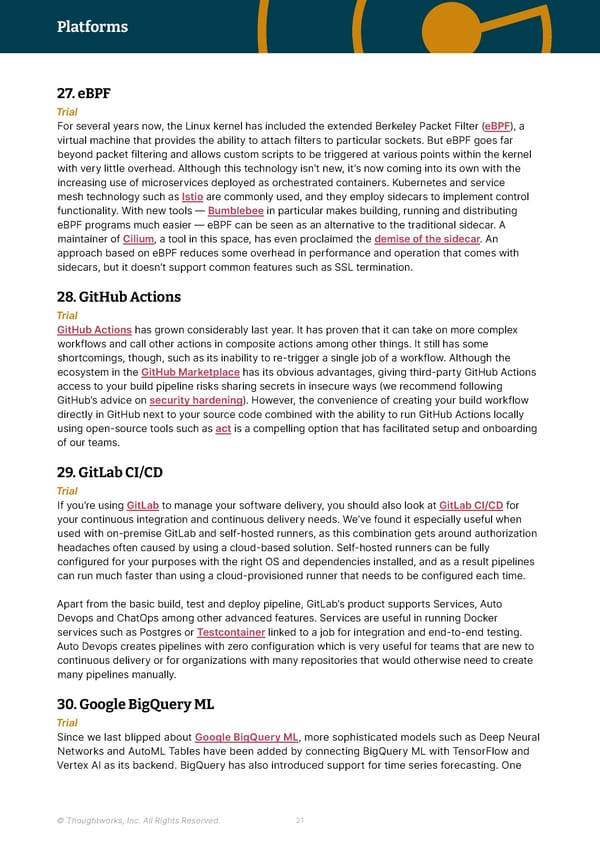Platforms Thoughtworks Technology Radar 27. eBPF Trial For several years now, the Linux kernel has included the extended Berkeley Packet Filter (eBPF), a virtual machine that provides the ability to attach filters to particular sockets. But eBPF goes far beyond packet filtering and allows custom scripts to be triggered at various points within the kernel with very little overhead. Although this technology isn’t new, it’s now coming into its own with the increasing use of microservices deployed as orchestrated containers. Kubernetes and service mesh technology such as Istio are commonly used, and they employ sidecars to implement control functionality. With new tools — Bumblebee in particular makes building, running and distributing eBPF programs much easier — eBPF can be seen as an alternative to the traditional sidecar. A maintainer of Cilium, a tool in this space, has even proclaimed the demise of the sidecar. An approach based on eBPF reduces some overhead in performance and operation that comes with sidecars, but it doesn’t support common features such as SSL termination. 28. GitHub Actions Trial GitHub Actions has grown considerably last year. It has proven that it can take on more complex workflows and call other actions in composite actions among other things. It still has some shortcomings, though, such as its inability to re-trigger a single job of a workflow. Although the ecosystem in the GitHub Marketplace has its obvious advantages, giving third-party GitHub Actions access to your build pipeline risks sharing secrets in insecure ways (we recommend following GitHub’s advice on security hardening). However, the convenience of creating your build workflow directly in GitHub next to your source code combined with the ability to run GitHub Actions locally using open-source tools such as act is a compelling option that has facilitated setup and onboarding of our teams. 29. GitLab CI/CD Trial If you’re using GitLab to manage your software delivery, you should also look at GitLab CI/CD for your continuous integration and continuous delivery needs. We’ve found it especially useful when used with on-premise GitLab and self-hosted runners, as this combination gets around authorization headaches often caused by using a cloud-based solution. Self-hosted runners can be fully configured for your purposes with the right OS and dependencies installed, and as a result pipelines can run much faster than using a cloud-provisioned runner that needs to be configured each time. Apart from the basic build, test and deploy pipeline, GitLab’s product supports Services, Auto Devops and ChatOps among other advanced features. Services are useful in running Docker services such as Postgres or Testcontainer linked to a job for integration and end-to-end testing. Auto Devops creates pipelines with zero configuration which is very useful for teams that are new to continuous delivery or for organizations with many repositories that would otherwise need to create many pipelines manually. 30. Google BigQuery ML Trial Since we last blipped about Google BigQuery ML, more sophisticated models such as Deep Neural Networks and AutoML Tables have been added by connecting BigQuery ML with TensorFlow and Vertex AI as its backend. BigQuery has also introduced support for time series forecasting. One © Thoughtworks, Inc. All Rights Reserved. 21
 Vol 26 | Technology Radar Page 20 Page 22
Vol 26 | Technology Radar Page 20 Page 22